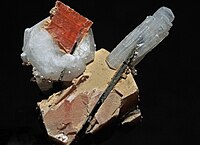
Photo from wikipedia
Large energy loss (Eloss) caused by defect‐assisted recombination makes the photovoltaic performance of carbon‐based perovskite solar cells (C‐PSCs) inferior to that of metal‐electrode ones. Herein, the influence of environmental factors… Click to show full abstract
Large energy loss (Eloss) caused by defect‐assisted recombination makes the photovoltaic performance of carbon‐based perovskite solar cells (C‐PSCs) inferior to that of metal‐electrode ones. Herein, the influence of environmental factors (moisture and oxygen) on defect management during re‐annealing process of CsPbI2Br crystalline films is systematically studied. Density functional theory and experimental results indicate that moisture in the air can significantly reduce the oxidation kinetics of crystalline films, resulting in orderly oxidation. Concomitantly, the oxidation decomposition products PbO and CsPbIBr2 are enriched at grain boundaries, passivating surface defects efficiently. Simultaneously, energy band coupling between CsPbI2Br and CsPbIBr2 improves the hole extraction efficiency. The photovoltage of corresponding C‐PSCs is increased from 1.05 to 1.32 V, indicating a reduced Eloss derived from orderly oxidation strategy. Correspondingly, the champion cell achieves an efficiency of 15.27%, and a certified efficiency of 14.7%, which is a new record efficiency for CsPbI2Br C‐PSCs.
Journal Title: Advanced Materials
Year Published: 2022
Link to full text (if available)
Share on Social Media: Sign Up to like & get
recommendations!